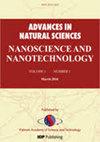用浇铸法合成用于光催化制氢的 PEDOT-Pt-TiO2 混合材料
IF 2.1
Q3 MATERIALS SCIENCE, MULTIDISCIPLINARY
Advances in Natural Sciences: Nanoscience and Nanotechnology
Pub Date : 2023-11-22
DOI:10.1088/2043-6262/ad095c
引用次数: 0
摘要
本研究首次描述了一种混合材料的合成和表征,这种材料由通过辐射分解的铂纳米粒子(Pt-TiO2 NTs)修饰的二氧化钛纳米管阵列(TiO2 NTs)和导电聚(3,4-亚乙二氧基噻吩)(PEDOT)层组成。通过两步阳极氧化工艺制备出的氮氧化钛,在不同含水量(2-10 vol%)的电解质溶液中呈现出不同的形态。聚(3,4-亚乙二氧基噻吩)-聚(苯乙烯磺酸)(PEDOT:PSS)聚合物层采用浇铸法涂覆在 Pt-TiO2 支架上。经过煅烧去除 PSS 部分后,PEDOT:PSS-PT-TiO2 纳米管在光催化过程中表现出稳定性;长度为 3 μm 的纳米管表现出最高的光催化活性(∼4.5 × 10-3μmol cm-2 of H2)。此外,从含水量为 5 和 10 Vol% 的电解质溶液中获得的样品显示出催化活性最高的纳米结构。本文章由计算机程序翻译,如有差异,请以英文原文为准。
A PEDOT-Pt-TiO2 hybrid material synthesized by the casting method for photocatalytic hydrogen generation
This study describes the synthesis and characterisation of a hybrid material consisting of titanium dioxide nanotube arrays (TiO2 NTs) modified by platinum nanoparticles (Pt-TiO2 NTs) via radiolysis and a conductive poly(3,4-ethylenedioxythiophene) (PEDOT) layer, for the first time. The NTs were fabricated by a two-step anodic oxidation process and exhibited different morphologies using electrolyte solutions with different water contents (2–10 vol%). The polymer layer of poly(3,4-ethylenedioxythiophene)-poly(styrenesulfonate) (PEDOT:PSS) was coated on the Pt-TiO2 scaffold using the casting method. The PEDOT:PSS-PT-TiO2 NTs exhibited stability in the photocatalytic process after additional calcination which was carried out to remove the PSS part; the nanotubes with lengths of ∼3 μ m exhibited the highest photocatalytic activity (∼4.5 × 10−3
μ mol cm−2 of H2). Additionally, the samples obtained from electrolyte solutions containing 5 and 10 vol% water exhibited nanostructures with the highest catalytic activity.
求助全文
通过发布文献求助,成功后即可免费获取论文全文。
去求助
来源期刊

Advances in Natural Sciences: Nanoscience and Nanotechnology
NANOSCIENCE & NANOTECHNOLOGYMATERIALS SCIE-MATERIALS SCIENCE, MULTIDISCIPLINARY
自引率
4.80%
发文量
0
 求助内容:
求助内容: 应助结果提醒方式:
应助结果提醒方式:


